Health Benefits of Olives Fresh
While commonly recognized as a high-fat food (about 80-85% of the calories in olives come from fat), olives are not always appreciated for the type of fat they contain. Olives are unusual in their fat quality, because they provide almost three-quarters of their fat as oleic acid, a monounsaturated fatty acid. (In addition they provide a small amount of the essential fatty acid called linoleic acid, and a very small amount of alpha-linolenic acid, an omega-3 fatty acid.) The high monounsaturated fat content of olives has been associated with reduced risk of cardiovascular disease. When diets low in monounsaturated fat are altered to increase the monounsaturated fat content (without becoming too high in total fat), research study participants typically experience a decrease in their blood cholesterol, LDL cholesterol, and LDL:HDL ratio. All of these changes lower our risk of heart disease.
Recent research studies have also shown that the monounsaturated fat found in olives (and olive oil) can help to decrease blood pressure. The oleic acid found in olives—once absorbed up into the body and transported to our cells—can change signaling patterns at a cell membrane level (specifically, altering G-protein associated cascades). These changes at a cell membrane level result in decreased blood pressure.
In terms of their phytonutrient content, olives are nothing short of astounding. Few high-fat foods offer such a diverse range of antioxidant and anti-inflammatory nutrients—some of which are unique to olives themselves. The list below shows some key phytonutrients in olives, organized by their chemical category:
- Simple Phenols
- tyrosol
- hydroxytyrosol
- Terpenes (including secoiridoids and triterpenes)
- oleuropein
- demethyloleuropein
- erythrodiol
- uvaol
- oleanolic acid
- elenoic acid
- ligstroside
- Flavones
- apigenin
- luteolin
- Hydroxycinnamic acids
- caffeic acid
- cinnamic acid
- ferulic acid
- coumaric acid
- Anthocyanidins
- cyanidins
- peonidins
- Flavonols
- quercetin
- kaempferol
- Hydroxybenzoic acids
- gallic acid
- protocatechuic acid
- vanillic acid
- syringic acid
- Hydroxyphenylacetic acids
- homovanillic acid
- homveratric acid
Given this phytonutrient richness, it’s not surprising that olives have documented health benefits that extend to most of our body systems. Olive benefits have been demonstrated for the cardiovascular system, respiratory system, nervous system, musculoskeletal system, immune system, inflammatory system, and digestive system. We believe that many of these diverse systems benefits are actually related to two underlying health-support aspects of olives, namely, their unusual antioxidant and anti-inflammatory nutrients. In this Health Benefits section, we will focus on those antioxidant and anti-inflammatory properties of olives, as well as some anti-cancer benefits that seem especially important with respect to this food.
Antioxidant Benefits
The vast majority of olive phytonutrients listed at the beginning of this section function as antioxidants and help us avoid unwanted problems due to oxidative stress. “Oxidative stress” is a situation in which our cells are insufficiently protected from potential oxygen damage, and oxidative stress can often be related to an insufficient supply of antioxidant nutrients. Olives are a good source of the antioxidant vitamin E, and they also contain small amounts of antioxidant minerals like selenium and zinc. However, it’s the phytonutrient content of olives that makes them unique as an antioxidant-rich food.
Perhaps the best-studied antioxidant phytonutrient found in olives is oleuropein. Oleuropein is found exclusively in olives, and it’s been shown to function as an antioxidant nutrient in a variety of ways. Intake of oleuropein has been shown to decrease oxidation of LDL cholesterol; to scavenge nitric oxide (a reactive oxygen-containing molecule); to lower several markers of oxidative stress; and to help protect nerve cells from oxygen-related damage.
One recent study that caught our attention has shown the ability of olives to increase blood levels of glutathione (one of the body’s premier antioxidant nutrients). In a very interesting research twist, study participants were not given fresh olives to eat but rather the pulpy residue from olives that had been previously milled to produce olive oil. Consumption of this olive pulp was associated with significantly increased glutathione levels in the blood of the participants, and improvement in their antioxidant capacity.
Interestingly, there may be common trade-offs made in the levels of different olive antioxidants during the maturation of olives on the tree. For example, the vitamin E content of olives may increase during early ripening when the total phenolic antioxidants in olives are slightly decreasing. Later on in the maturation process, these trends may be reversed.
Anti-Inflammatory Benefits
In addition to their function as antioxidants, many of the phytonutrients found in olives have well-documented anti-inflammatory properties. Extracts from whole olives have been shown to function as anti-histamines at a cellular level. By blocking special histamine receptors (called H1 receptors), unique components in whole olive extracts help to provide us with anti-inflammatory benefits. In addition to their antihistamine properties, whole olive extracts have also been shown to lower risk of unwanted inflammation by lowering levels of leukotriene B4 (LTB4), a very common pro-inflammatory messaging molecule. Oleuropein—one of the unique phytonutrients found in olives—has been shown to decrease the activity of inducible nitric oxide synthase (iNOS). iNOS is an enzyme whose overactivity has been associated with unwanted inflammation. Taken as a group, these research findings point to olives as a uniquely anti-inflammatory food.
The anti-inflammatory benefits of olives have been given special attention in the area of cardiovascular health. In heart patients, olive polyphenols have been determined to lower blood levels of C-reactive protein (CRP). CRP is a widely used blood measurement for assessing the likelihood of unwanted inflammation. Olive polyphenols have also been found to reduce activity in a metabolic pathway called the arachidonic acid pathway, which is central for mobilizing inflammatory processes.
Anti-Cancer Benefits
The antioxidant and anti-inflammatory properties of olives make them a natural for protection against cancer because chronic oxidative stress and chronic inflammation can be key factors in the development of cancer. If our cells get overwhelmed by oxidative stress (damage to cell structure and cell function by overly reactive oxygen-containing molecules) and chronic excessive inflammation, our risk of cell cancer is increased. By providing us with rich supplies of antioxidant and anti-inflammatory nutrients, olives can help us avoid this dangerous combination of chronic oxidative stress and chronic inflammation.
Research on whole olives and cancer has often focused on two cancer types: breast cancer and stomach (gastric) cancer. In the case of breast cancer, special attention has been paid to the triterpene phytonutrients in olives, including erythrodiol, uvaol and oleanolic acid. These olive phytonutrients have been shown to help interrupt the life cycle of breast cancer cells. Interruption of cell cycles has also been shown in the case of gastric cancer, but with this second type of cancer, the exact olive phytonutrients involved are less clear.
One of the mechanisms linking olive intake to cancer protection may involve our genes. Antioxidant phytonutrients in olives may have a special ability to protect DNA (deoxyribonucleic acids)—the key chemical component of genetic material in our cells—from oxygen damage. DNA protection from unwanted oxidative stress means better cell function in wide variety of ways and provides cells with decreased risk of cancer development.

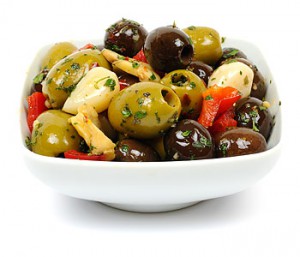 The full-body and flavour of our succulent purple and green olives are complimented by the bite of juicy red peppers and the crunch of sweet garlic cloves, dusted by herbes de Provençe.
The full-body and flavour of our succulent purple and green olives are complimented by the bite of juicy red peppers and the crunch of sweet garlic cloves, dusted by herbes de Provençe.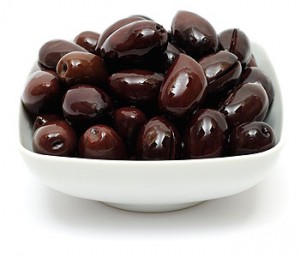 These deep black plump olives are from the Kalamata area of Greece. They have been packed in an all-natural oil and brine mixture, for added flavour and to lock in freshness.
These deep black plump olives are from the Kalamata area of Greece. They have been packed in an all-natural oil and brine mixture, for added flavour and to lock in freshness.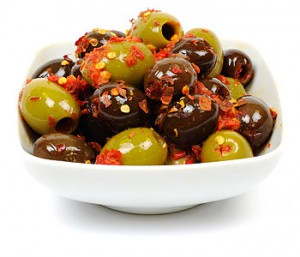 Mixed green and black pitted olives, dressed with a flavourful hot and spicy Harissa chilli pepper paste with the addition of crushed lemon.
Mixed green and black pitted olives, dressed with a flavourful hot and spicy Harissa chilli pepper paste with the addition of crushed lemon.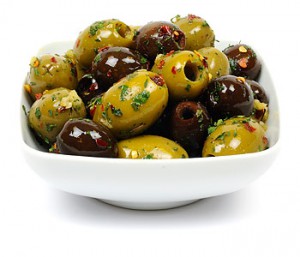 Pitted Greek green and Kalamata olives with organic rosewater, chilli and aromatic spices to add a unique Mediterranean touch to any dish.
Pitted Greek green and Kalamata olives with organic rosewater, chilli and aromatic spices to add a unique Mediterranean touch to any dish.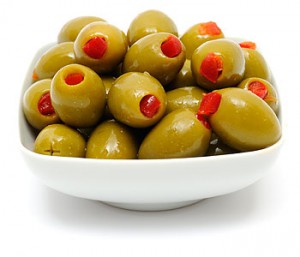 Large green olives stuffed with sliced jalapeno, the spicy and more aromatic relative of the red pepper. They make an excellent snack by themselves or a classic addition to various dishes.
Large green olives stuffed with sliced jalapeno, the spicy and more aromatic relative of the red pepper. They make an excellent snack by themselves or a classic addition to various dishes.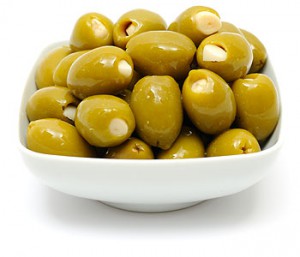 Succulent olives stuffed with a whole clove of garlic treated so that it retains all of its crunch and sweetness and offers only the most subtle garlic flavour.
Succulent olives stuffed with a whole clove of garlic treated so that it retains all of its crunch and sweetness and offers only the most subtle garlic flavour.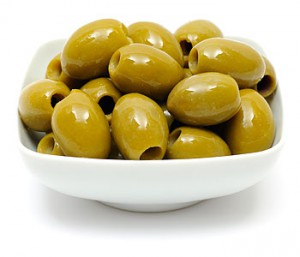 Grown in the Halkidiki region of Northern Greece, these pale green pitted olives offer a firm texture and provide a slightly tart and peppery flavour.
Grown in the Halkidiki region of Northern Greece, these pale green pitted olives offer a firm texture and provide a slightly tart and peppery flavour.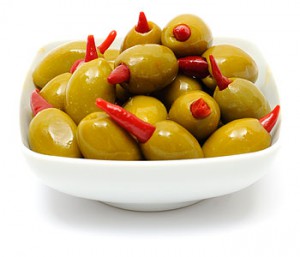 Premium large green olives, stuffed with red hot piri-piri chilli peppers for a zingy, tongue-tingling treat or unique addition to any dish.
Premium large green olives, stuffed with red hot piri-piri chilli peppers for a zingy, tongue-tingling treat or unique addition to any dish.